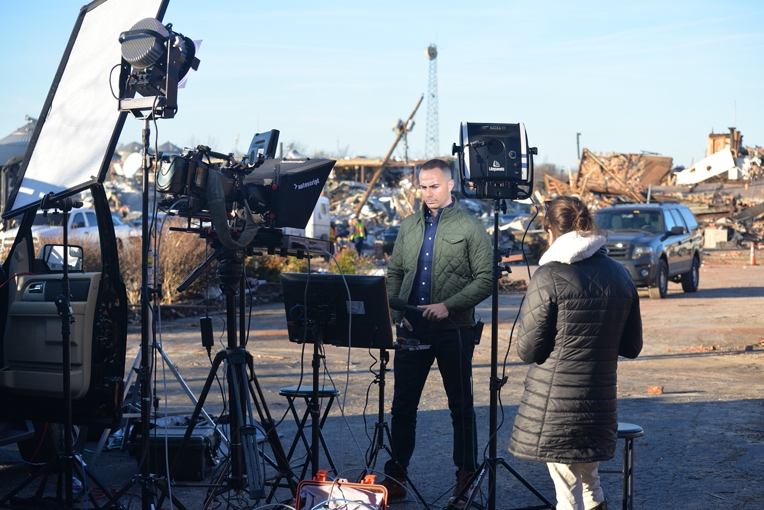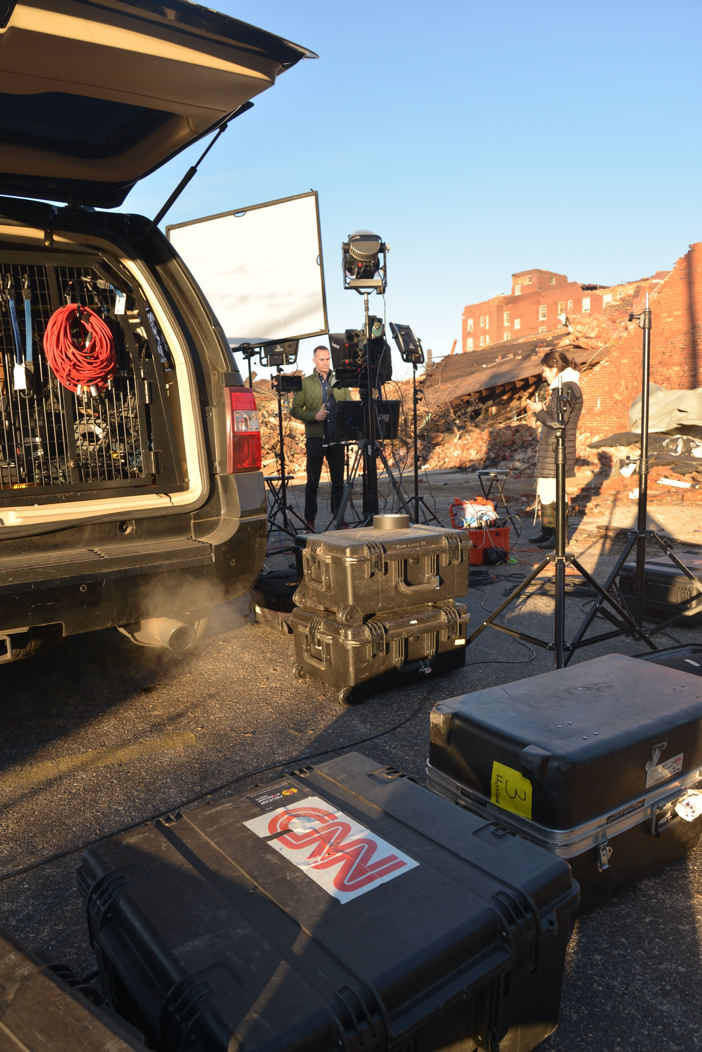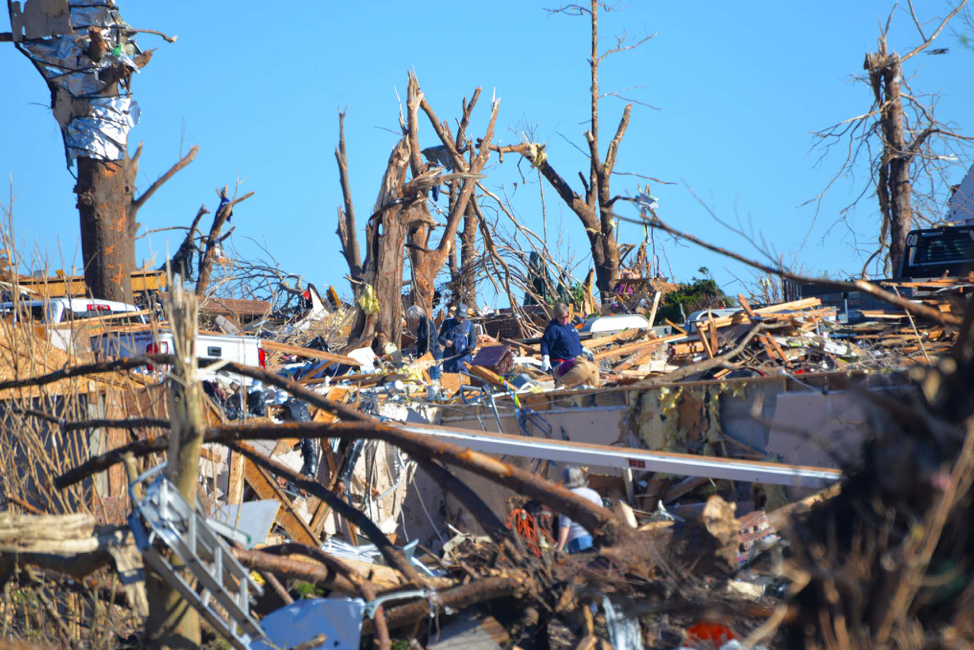This is one of 10 essays I offer as we close 2021 that I hope will help broadcast journalists tell stronger stories in the year ahead.
One of the first things that a college professor taught me about writing for television was that “words and pictures should match.” It took me several years to figure out that advice and that professor were wrong.
Let’s imagine I was doing a story about the massive amount of logistics that go into network news crews’ coverage of the Mayfield, Kentucky, tornado this month. Imagine I use video of CNN anchor Boris Sanchez about to go on the air.

(Al Tompkins/Poynter)
My college professor’s make-the-words-and-pictures-match rule would have me writing something like, “CNN reporter Boris Sanchez stands in a parking lot about to go on the air. There is debris in the background.” But the viewer could clearly see all of that. There is no need for me to say what you can clearly see.
If I explain the video rather than narrate it, I can add more information than the viewer would know without me. I could say, “CNN anchor Boris Sanchez has covered hundreds of emergencies from mass shootings and riots to hurricanes and earthquakes around the world. He says this job requires him to set aside sentimentality and focus on the facts.”
If I showed a clip of the next scene, I could say, “Network TV crews use lots of lights and other gear.”

(Al Tompkins/Poynter)
But if I explained the video rather than narrate it, I might say, “A network crew needs all of this to pull off a live shot while a local TV journalist might be out here alone with a camera, tripod and cellphone.”
If you had video of the tornado damage you could say, “In, Princeton, Kentucky, the storm destroyed trees and houses.”

(Al Tompkins/Poynter)
Or you could explain the video by saying, “This was once the nicest part of town.”
While you should explain and not narrate the video, it is important to also keep this mantra in mind: Words and pictures should not compete.
Hang on, a little bit of visual theory
Ann Marie Seward Barry, associate professor of communication at Boston College, cited a study by the Educational Foundation of the American Association of Advertising Agencies that shows that even when we see images on television, we usually don’t understand them.
Barry writes, “Even when we watch television, we misunderstand approximately 30% of what is shown to us. Our emotional state, our mindset at the time and our experience all seem to conspire against our seeing things as they really are. We go about our lives, however, mostly assuming that what we see really ‘is,’ as if there were no intermediary process.”
There is no doubt, Barry said, that visual communication dominates verbal communication. It is a powerful notion for television journalists to consider. Pictures overwhelm the words they cover. But if the words inform the pictures, there is no verbal/visual competition.
How do viewers misunderstand a third of what they see on TV? The answer may lie in how they process the images they see. Once you understand the theory behind how we process images, you can begin to form your own ideas about how to write to them.
Gestalt psychology, a term derived from the German term gestalten or “organized wholes,” is a theory of perception. This short exploration of visual perception will help you understand the power and potential for television visuals, including photographic images, graphics and animation.
Gestalt theory maintains that the mind has innate organizational abilities that allow us to deconstruct a whole image into various components without having to actively analyze them. So, you can see one, then the other — the faces, then the vase — without much thought about either.
Vision goes on between the eye and the brain, but perception is a process entirely within the mind.
The guiding principle of Gestalt psychology is that the larger picture will be seen before its component parts. This has particular relevance for television news and is effectively the psychological equivalent of the old saying, “The whole is bigger than the sum of its parts.” Break a story into component parts (using different focal lengths and angles) and viewers begin to understand the scene more fully. By varying shots, you allow the brain to analyze the story from many points of view.
Probably the most important Gestalt concept is the theory that in any visual display there is always one element that will be perceived as the object. Everything else is perceived as background. In television, we clutter our screens with information we think will appeal to viewers. In fact, the brain is not able to process so much information.
Another guiding principle of Gestalt psychology is that when there are a number of possible interpretations, we automatically choose the one for which we need the least amount of additional information. We associate visual images with personal experiences. It is a way of saying, “The viewer will see what he or she wants to see.”
If a newscast aired a story in which demonstrators were chanting antigovernment slogans, my father might see that story as being “anti-American.” I might see the same story as being a demonstration of the power of protected free speech. We filter stories through our own experiences, and we turn first to the interpretation we understand most. We choose the interpretation that is the most obvious to our own eyes and brain.
That is why it is so important for you to explain the image, not just tell me what I can already see. Explaining the image means adding understanding beyond what I perceive.
Reporters sometimes challenge me when I teach this concept saying, “Yes but sometimes people are just listening to TV, not watching it.” It’s true. But if you are just telling them what they would be seeing if they looked at the screen, you have just given them a reason not to watch. Enrich their experience by using the power of words and pictures.
In my next column, we will explore another critical element to powerful storytelling, natural sound, which, I will argue, not only enriches storytelling but also can allow you to use fewer words and less airtime.
(Some ideas in this series are included in my college textbook, “Aim for the Heart.”)
Al Tompkins will expand on his storytelling and writing teaching in two Poynter seminars: The Poynter Producer Project and TV Power Reporting. Click the links to see the schedules, meet our all-star visiting faculty and apply. Thanks to a grant from CNN, we offer 50% tuition scholarships to NABJ, NAHJ, AAJA, NAJA and NLGJA members. Both seminars take place over three days at Poynter in St. Petersburg, Florida, or you can attend virtually.






